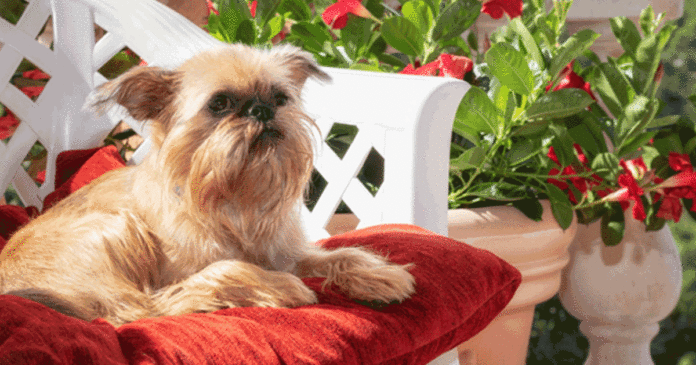The ancestry of the Brussels Griffon dog dates back to when small dogs were kept for rat hunting in stables. This toy-sized dog weighs between 8-10 pounds. It has a thick body and a flat face with dark eyes. The breed is quite sensitive and bonds strongly with its owner, which makes it a good companion, a watchdog, or a family dog.
Griffons are better off as indoor dogs because of their physical characteristics and temperament. You can visit holistapet to get more information about the breed. In this article, we will discuss all you should know about raising a healthy Brussels griffon.
An Overview of the Breed Development
The development of a Brussels griffon spans 14 to 16 months from the time of its delivery to complete maturity. Physically, the puppies grow quickly in height and length within the first five to six months. Afterward, they experience a slow growth rate by amassing fat and muscle mass.
An adult Griffon has a height of 8 inches and weighs 10 pounds on average at ten to eleven months. Below are the expected milestones in the development of a Brussels Griffon dog.
- 2 to 3 weeks – begin walking, ears/eyes open.
- 2 months – can be separated from its mother, introduced to different types of food, housetraining.
- 3 months – can start exercising; de-worming or vaccination is required.
- 4 to 5 months – the onset of adolescence, characterized by disobedience, hyperactivity, and increased fear; obedience training is highly recommended.
- 9 months – can transition to adult meals; sexual maturity.
- 15 months and above – adulthood.
Socialization and Training
The steps below will help you train and socialize your BG.
1. Introduce Them to Different Places and People
It is important to socialize your dog early. When going places, take them along with you to expose them to different environments, other dogs, and strangers, including family pets and family members. Socialization helps the breed overcome its soft personality and prevent fear and shyness.
Griffons can stay with other pets; however, they may want to dominate dogs that are far bigger than them. They have tendencies to suffer from prolonged trauma, so try to keep them away from negative experiences. When they are fearful, they may become defensive.
2. Positive Reinforcement
When training a BG, use a lot of positive reinforcements when they behave well. Griffons love to please people and will always want to do your bidding if your instructions are clear enough. Try not to coerce them, so things can go as planned. You can read this article to learn how to use positive reinforcement.
3. Create a Routine
When you bring a Brussels Griffon home, you need to crate-train them to ensure effective housetraining. They should never stay home alone as this can lead to difficulties in housetraining as well as other behavioral problems. Also, your BG may have problems with staying consistent, but you can work on it by studying their habits and sticking to a routine.
Grooming
Griffons are hairy and require brushing twice each week. You do not need to bathe them regularly; only when necessary. The coat could either be smooth or rough.
Smooth coats are straight, glossy, and short. They do not require much grooming; however, they shed seasonally. A pair of gloves with grooming pads on the sides can help to make smooth coats glossier. The rough coats, on the other hand, are furnishings. They need grooming, but you can keep them shaggy.
If you prefer to strip your BG’s rough coat, you can do it by hand, but this is optional. Experts recommend clipping the coat every 3 months to keep it in shape. Also, trim the fringes around their face, so they can retain a desirable appearance and expression.
Additionally, the hairs in your BG’s ear canals can come off if you pull them with your fingers. If you are not comfortable doing this, you can hire a groomer or meet a vet. Ensure you use cotton balls and a solution that the vet approves of to clean the dog’s ears.
Exercise and General Health
Griffons are faced with certain health problems that are common to breeds with flat faces and short muzzles. They easily suffer heatstroke, airway obstruction, and respiratory issues. Their eyes are also prone to damage because of their short muzzles and protruding eyes.
Other health problems you should be aware of are:
- Glaucoma
- Cataracts
- Progressive retinal atrophy
- Thyroid problems
- Patellar luxation
- Hip dysplasia
- Slipped stifle
- Cavities in the spinal cord that are filled with fluid
- Syringomyelia
You can click on https://www.yourpurebredpuppy.com/health/brusselsgriffons.html to read more about health problems in Brussels Griffon dogs and the treatment options.
Griffons require daily walks as it helps to control their weight, reduce stress, and promote general health. They are also good candidates for activities like agility and obedience training. However, you should take care when exercising your dog when the weather is hot.
Remember that this breed is an indoor breed, so when you bring them into the yard to play, always keep an eye on them. Also, ensure that the play area is safe because sharp objects within their eye level can damage their prominent eyes.
Finally, you need to know the costs of breeding a BG. Not only is it expensive and difficult, but the head formation and size make whelping risky and tough. The breed also experiences a high puppy death rate and birth defects. As a result, the pups need a lot of care.
Conclusion
Brussels Griffons are small and lively. They are quite rare, and their owners hold them dearly. We listed the developmental milestones of the breed as well as details on raising a healthy BG: socialization, grooming, and exercise.







